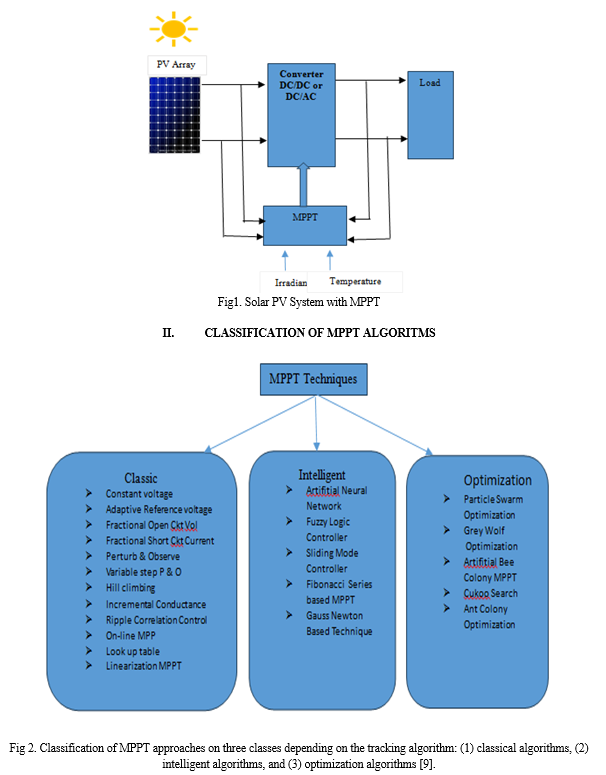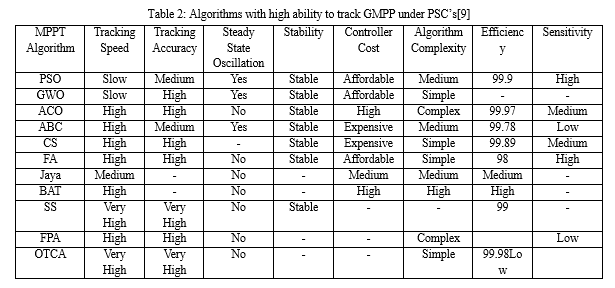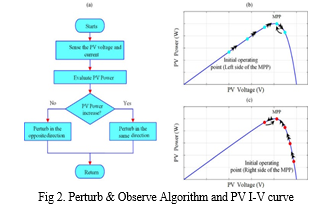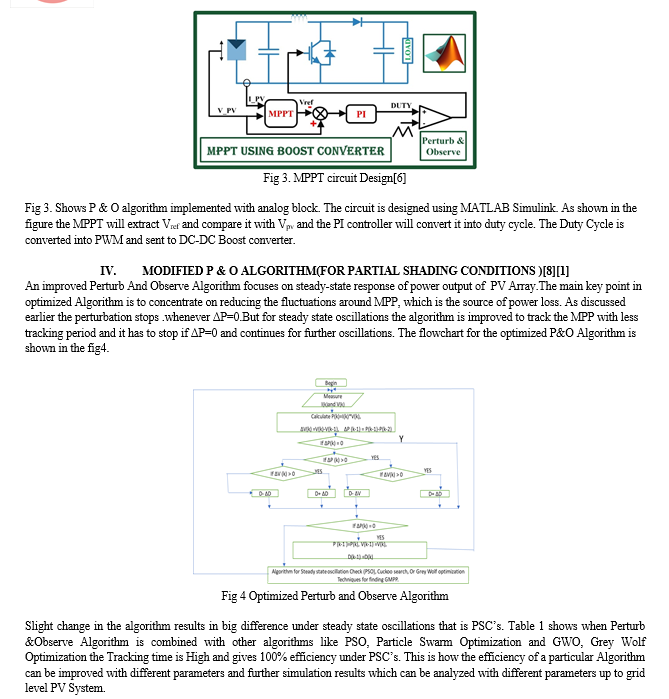Ijraset Journal For Research in Applied Science and Engineering Technology
- Home / Ijraset
- On This Page
- Abstract
- Introduction
- Conclusion
- References
- Copyright
Optimized Perturb and Observe Techniques for Sudden Irradiance and Temperature Change
Authors: Prof. Savita S Kudakunti, Dr. Vijay Kumar C N
DOI Link: https://doi.org/10.22214/ijraset.2024.59070
Certificate: View Certificate
Abstract
Solar Power generation plays vital role in RES due to its natural abundance and environment friendly. The efficiency of the PV System depends on the more optimized MPPT Technique. Several methods for extracting GMPP are discussed that works better on steady state oscillations and fast tracking time. In this paper all recent techniques for MPPT are discussed and more efficient algorithm and simple in approach is revealed. This paper tries to find more efficient algorithm with fast tracking speed and optimized duty cycle.
Introduction
I. INTRODUCTION
Among the Renewable Energy Sources(RES),solar energy is most promising renewable energy sources as it is available as a clean energy in abundance. Solar PV panels convert solar energy to electricity. This energy can power devices or be saved in batteries. Among many mppt techniques the main goal is minimizing fluctuation systems over maximum power point and increasing maximum point with increasing efficiency and tracking speed under steady state and rapid climate change .To reduce environmental impacts many countries are focusing on power generation from non-conventional energy sources rather than conventional energy sources. Power generated from solar PV is not constant throughout the day because of continuous varying weather condition and also it is available in the day time. Power generated from PV is maximum only at one point for given irradiance(w/m2) and temperature (oC) and is measured as maximum power point of PV [1]. A PV system can be stand-alone or grid connected. In case of grid and commercial aspects the authors discussed a wide range of MPPT algorithms. They are categorized in terms of parameter estimation, usage of sensors, computation time, controller complexity, variable step size perturbation, tracking speed and their implementation cost. The key ideas behind all developed MPPT algorithms are to track the MPP faster and more accurate in varying irradiance condition with low power oscillations. In grid connected PV system, the energy produced is consumed on-site or sold to the grid in surplus production[9].Stand-alone system is used in villages and isolated companies in remote areas. Hence designing maximum power point tracking algorithm plays a vital role in solar PV system. Among many algorithms P &O algorithm focuses on pertebating voltage of the PV panel. Generally in the conventional P&O based MPPT algorithm, the voltage and power of PV system are measured instantaneously, and then the voltage is adjusted as increment or decrement to reach the MPP for appropriate direction with its fixed step size. The main drawback of the conventional P&O algorithm is its tracking direction, step size and oscillation around MPP in During uniform isolation, classical methods are highly preferred as there is only one peak in the P-V curve. However, under (Partial Shading Conditions)PSCs, the P-V curve exhibits multiple peaks, one global maximum power point (GMPP) and remaining are local maximum power points (LMPP’s). Under the PSCs, classical methods fail to operate At GMPP and hence there is a need for more advanced MPPT techniques. Every MPPT technique has its advantages and limits, but a more accurate MPPT is drafted in numerous parameters like sensors required, hardware implementation, costviability, tracking speed, tracking efficiency[3].sudden variation in irradiance condition and it requires a PI controller to tune the control parameter. In order to overcome these issues, a modified Perturbation and observation based MPPT algorithm is proposed in [8] . According to the United Nations Environment Program (UNEP) briefing note on its Sustainable Development Goal 7 (SDG 7), electricity is unavailable for billion people in the world while more than three billion people use solid fuels like wood still cook their food and heat their homes.With these wasteful practices and air pollution about four million people die. To reduce human health problems around the globe, UNEP calls for a reduction of emissions caused by fuel combustion by 40%. Achieving SDG 7 will certainly act to have a positive impact on other SDGs such as combating climate change (SDG 13) and helping to end global poverty (SDG1) by achieving energy justice in developing countries [9]. Among the renewable energy sources (RES), solar energy is the promising alternative and the most useful energy from an ecological point of view as it is an available and a clean energy. Fig 1 shows the PV System using MPPT.

Table 1. Hybrid based MPPT Techniques[3]
|
Parameters |
FPSO |
ANFIS |
GWO-P&O |
PSO-P&O |
HC-ANFIS |
|
Tracking Speed |
High |
High |
Medium |
High |
High |
|
Tracking accuracy |
High |
Medium |
High |
Medium |
High |
|
Control strategy |
FIS and bio-inspired |
Sampling Mode |
Bio-inspired |
Fine tuning of D |
Two step process |
|
Sensed Parameters |
V &C |
V&C |
V |
V &C |
V & C |
|
Complexity |
Simple |
Medium to Complex |
Medium |
Medium to complex |
Simple |
|
Parameter tuning |
No |
Yes |
Yes |
Yes |
No |
|
Stability |
Very Stable |
Stable |
Stable |
Stable |
Very Stable |
|
Analog/Digital |
Digital |
Digital |
Digital |
Digital |
Digital |
|
Grid Integration |
Yes |
Yes |
Yes |
Yes |
Yes |
|
Cost |
Very Expensive |
Expensive |
Affordable |
Affordable |
Expensive |
|
Ability to track under PSC’s |
High |
High |
High |
High |
High |
|
Efficiency |
- |
99.562 |
99.77 |
100 |
- |
MPPT Techniques on different approaches is depicted in the fig 2. New trends on GMPP is discussed in Table 1.This discussion shows that use of metaheuristic and algorithms like PSO,GWO, etc. Comparative analysis between most used Metaheurestic methods with high ability to track GMPP under PSC’s is shown in Table 1. Conventional methods like Perturb and Observe ,INC and HC used for comparative studies with new proposed methods are simple but less accurate under PSC’s. The intelligent prediction methods such as FLC, ANN are efficient but are more expensive[9]. New Swarm algorithms and improved ones have shown better performance. The contribution of the new swarm algorithms was proved in terms of stability, oscillations around MPP, efficiency, settling time, robustness, and sensitivity to different shading scenarios and dynamically varying isolation conditions.
A. Comparison table for more optimised mppt Algorithm
To explore the new trends around MPPT approaches, Table 2 shows the Analysis of different algorithms .It show that use of metaheuristic swarm algorithms including PSO,GWO,ACO and so on. Comparative analysis shows that Conventional methods like P&O, INC, and HC with new proposed methods are simple but less exact in PSC’s[9].However their responses are slow under PSC’s .The intelligent prediction methods such as FLC,ANN, or ANFI have the abilities to manage non-linearities. but they are expensive, complex to implement and not efficient for simple applications. Further they need huge amount of data which imposes extreme load on process memory.
Hence by proposing new hybrid approaches .The objective is to improve the performance of GMPP algorithms by increasing the tracking efficiency and lowering computation burden of hardware. Further by combining online like perturb and observe ,Incremental conductance, Hill climbing etc and off-line methods like constant voltage, constant current, Look-up table etc can lead to better performance always[9].
The various parameters for Hybrid based MPPT Technique is given in the Table 1 [3]. Further P&O Algorithm is discussed which when combined with other methods can be applied for its simplicity and easy implementation. They can be applied for their algorithm lower complexity making them the best Techniques for simple application not requiring high performance.

III. P & O ALGORITHM(FOR STABLE CONDITION )
For every PV System there is a single operating point known as Maximum Power Point in I-V and V-P curves for each temperature and irradiation condition. Whenever temperature changes the MPP changes its position. Hence MPPT Algorithm is designed to track the MPP . They play an important role in Solar PV System. The general system is depicted in Fig 1.
Perturb & Observe Algorithm is designed to increase or decrease the terminal voltage or current at regular interval and comparing the output power of PV with previous samples[6]. The P&O algorithm is known for its simple implementation and good excellent tracking efficiency. MPPT P & O algorithm is used to study the behaviour of the PV I-V curve . Through this P&O method, the MPPT controller will observe the PV output power and it will perturb the PV output power either increment or decrement depends on the increment of PV voltage or current as predicted in Fig 2. In this method the present value is compared with PV output power that was calculated with the past value that gives the differences in power. The algorithm will continue to perturb the PV operating voltage by a small increment. If the changes in power (ΔP) value is positive, it will move towards the direction of maximum power point and the operating voltage will continue to be perturb in the same direction. If the result of the perturb process leads to negative in ΔP. It will move away from the maximum power point and the sign of the perturbation is changed[6].
Fig 2 shows the flowchart of P & O Algorithm operation and PV I-V curve.


Conclusion
Since from many years effort is being made to improve the efficiency of the PV System. Algorithms should be carefully evaluated to bring simplicity and consistency and improve overall efficiency in terms of high tracking efficiency and less steady state oscillations in rapidly changing weather conditions. With all the above discussions of different algorithms. Perturb and Observe algorithm when modified by comparing different parameters leads to more simple and to be a more accurate Algorithm. Most efficient MPPT Technique which is more efficient in terms of simplicity in implementation and accuracy can be found. They work very well for fast convergence, precision, and ability to predict non-linearities of a PV cell without falling to local MPP under Partial Shading Conditions. For further work ,P & O Algorithm can be modified by combining other algorithms and simulation results can be analyzed with grid level PV System.
References
[1] Mohannad Jabbar Mnati, Victor Gino Morais Araujo, Jameel Kadhim Abed , ” Review Different Types of MPPT Techniques for Photovoltaic Systems ,June 2018. [2] MAHESWARAN GUNASEKARAN 1,2, (Member, IEEE), VIJAYAKUMAR KRISHNASAMY 1 , (Senior Member, IEEE), SIVAKUMAR SELVAM 3 , (Member, IEEE), DHAFER J. ALMAKHLES 3 , (Senior Member, IEEE), AND NORMA ANGLANI 2 , (Senior Member, IEEE),” An Adaptive Resistance Perturbation Based MPPT Algorithm for Photovoltaic Applications”,IEEE,Volume 8 ,2020. [3] MANSI JOISHER1 , DHARAMPAL SINGH2 , SHAMSODIN TAHERI 3 , (Senior Member, IEEE), DIEGO R. ESPINOZA-TREJO 4 , EDRIS POURESMAEIL 5 , (Senior Member, IEEE), AND HAMED TAHERI 6,” A Hybrid Evolutionary-Based MPPT for Photovoltaic Systems Under Partial Shading Conditions”,IEEE,Volume 8,2020. [4] Ratnakar Babu Bollipo, Suresh Mikkili , Senior Member, IEEE, and Praveen Kumar Bonthagorla, Member, IEEE, CSEE JOURNAL OF POWER AND ENERGY SYSTEMS,” Hybrid, Optimal, Intelligent and Classical PV MPPT Techniques: A Review ” VOL. 7, NO. 1, JANUARY 2021. [5] Jalal Dadkhah and Mehdi Niroomand,” Optimization Methods of MPPT Parameters for PV Systems: Review, Classification, and Comparison”, JOURNAL OF MODERN POWER SYSTEMS AND CLEAN ENERGY, VOL. 9, NO. 2, March 2021. [6] Muhammad Zakwan Nazeri 1 , Nadia Hanis Abd Rahman2,” Maximum Power Point Tracking Using Perturb and Observe Technique”, Journal of Engineering Technology Vol. 10(1): 204-210, 2022 ISSN 2231-8798© 2013 UniKL BMI. [7] MUHANNAD J. ALSHAREEF,” An Effective Falcon Optimization Algorithm Based MPPT Under Partial Shaded Photovoltaic Systems”,IEEE,Volume 10,2022. [8] Rasool Kahani, Mohsin Jamil, and M. Tariq Iqbal,” An Improved Perturb and Observed Maximum Power Point Tracking Algorithm for Photovoltaic Power Systems”, JOURNAL OF MODERN POWER SYSTEMS AND CLEAN ENERGY, VOL. 11, NO. 4, July 2023. [9] RAFAH IBRAHEEM JABBAR 1,2, (Graduate Student Member, IEEE), SAAD MEKHILEF 1,3, (Fellow, IEEE), MARIZAN MUBIN 1 , AND KARAM KHAIRULLAH MOHAMMED 4 , (Student Member, IEEE),” A Modified Perturb and Observe MPPT for a Fast and Accurate Tracking of MPP Under Varying Weather Conditions”,Volume 11, 2023. [10] Olfa Boubaker1,” MPPT techniques for photovoltaic systems: a systematic review in current trends and recent advances in artifcial intelligence”,Discover energy,2023.
Copyright
Copyright © 2024 Prof. Savita S Kudakunti, Dr. Vijay Kumar C N. This is an open access article distributed under the Creative Commons Attribution License, which permits unrestricted use, distribution, and reproduction in any medium, provided the original work is properly cited.

Download Paper
Paper Id : IJRASET59070
Publish Date : 2024-03-16
ISSN : 2321-9653
Publisher Name : IJRASET
DOI Link : Click Here
 Submit Paper Online
Submit Paper Online

